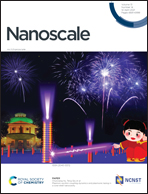Plasmon–exciton coupling dynamics and plasmonic lasing in a core–shell nanocavity†
Abstract
Plasmonic nanolasers based on the spatial localization of surface plasmons (SPs) have attracted considerable interest in nanophotonics, particularly in the desired application of optoelectronic and photonic integration, even breaking the diffraction limit. Effectively confining the mode field is still a basic, critical and challenging approach to improve optical gain and reduce loss for achieving high performance of a nanolaser. Here, we designed and fabricated a semiconductor/metal (ZnO/Al) core–shell nanocavity without an insulator spacer by simple magnetron sputtering. Both theoretical and experimental investigations presented plasmonic lasing behavior and SP-exciton coupling dynamics. The simulation demonstrated the three-dimensional optical confinement of the light field in the core–shell nanocavity, while the experiments revealed a lower threshold of the optimized ZnO/Al core–shell nanolaser than the same-sized ZnO photonic nanolaser. More importantly, the blue shift of the lasing mode demonstrated the SP-exciton coupling in the ZnO/Al core–shell nanolaser, which was also confirmed by low-temperature photoluminescence (PL) spectra. The analysis of the Purcell factor and PL decay time revealed that SP-exciton coupling accelerated the exciton recombination rate and enhanced the conversion of spontaneous radiation into stimulated radiation. The results indicate an approach to design a real nanolaser for promising applications.



 Please wait while we load your content...
Please wait while we load your content...